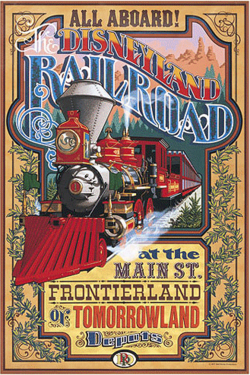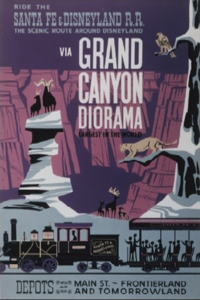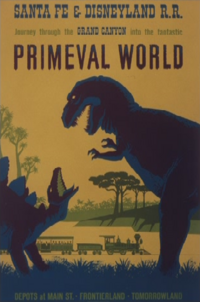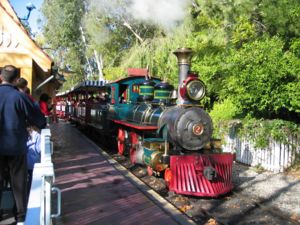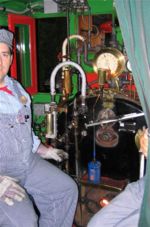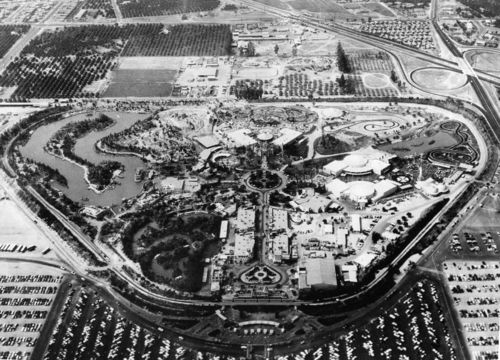Disneyland Railroad
The Disneyland Railroad (DRR) is a narrow-gauge railroad located at Disneyland in Anaheim, California, United States, that was inaugurated on that theme park's opening day, July 17, 1955. The live steam railway was constructed at a cost of US$240,000 and each of the original four locomotives cost in excess of $40,000 either to build or restore. It remains one of Disneyland's most popular attractions as riders can use it as transportation to other areas of the park or to simply ride the trains on the so-called "grand circle tour." Unlike the Disneyland Monorail System, which requires riders to disembark at the Tomorrowland station, passengers on the DRR can remain on the trains for as long as they wish. The railroad is the first thing visitors see upon entering Disneyland through the main entrance.
Contents
Layout
Laid to 3 ft (914 mm) gauge, the most common narrow gauge used in North America, the train's track runs in a continuous loop around the park, which has subsequently expanded past the tracks in some places. The line features several grade crossings, including one located near It's a Small World, automatic block signals, and a roundhouse for locomotive storage, located backstage behind It's a Small World and shared with the Monorail.
Under the original track plan, two trains (one freight and one passenger) could operate on the railroad simultaneously, running in the same direction. A passing track was incorporated at Main Street station where one train had to wait to allow the other to pass. Later, for safety reasons, and to allow the use of more than two trains, the line was changed so that trains followed behind each other, and no longer passed. The passing track was disconnected and now is only used to display a handcar. Walt Disney dictated that a minimum of two trains were to operate at all times, and it is not uncommon for three or four trains to run simultaneously on busy days.
As the train passes behind the It's a Small World attraction in Fantasyland, it crosses a service road that is protected by two miniature wigwag crossing signals. The Santa Fe Railway offered the use of full-scale crossing signals, but Disney declined as they would be out of scale with the trains. These scaled-down replicas were designed and built by the San Bernardino shops of the Santa Fe as a gift to Disneyland. They operate with automotive windshield wiper motors.
Rail cars
Passenger seating originally consisted of forward-facing bench seats in several railcars. The 1958 addition of the "Grand Canyon/Primeval World" diorama necessitated a change in the rolling stock; instead of facing forward, the benches of the cars were changed to face right so that the diorama could be better enjoyed by the passengers.
Today the seating consists mostly of open-air, freight-styled coaches with bench seating still facing right for ease of loading and unloading at the depots and for easier viewing of the "Grand Canyon/Primeval World" diorama. Five open-air, clerestory-roofed observation cars with forward-facing seats dating from the park's opening were removed from service shortly after the diorama's opening in 1958 but were returned to service in 2004 after undergoing a three-year restoration. One trainset, the Excursion III, still faces forward. The Lilly Belle presidential coach is occasionally added to the rear of a train, as is an enclosed wooden caboose. In 2006, Disney added the first new steam engine in 47 years, The Ward Kimball, named after a legendary Disney animator.[1]
History
From concept to inauguration
The Disneyland Railroad was inspired by Walt Disney's love for trains and his live steam backyard Carolwood Pacific Railroad, a love he shared with Disney animators Ward Kimball and Ollie Johnston. Until 1974, it was sponsored by the Atchison, Topeka and Santa Fe Railway, during which time it operated as the Santa Fe & Disneyland Railroad.
The train originally consisted solely of custom-built, five-eighths-scale equipment. The Walt Disney Company constructed the original two locomotives in its own workshops under the supervision of Roger E. Broggie. Patterned after the Lilly Belle, a miniature steam locomotive Broggie had made for Walt's backyard Carolwood Pacific Railroad, these were also models of classic "Wild West"-style American 4-4-0s, but built to a larger five-eighths scale. No. 1 was given a big wood-burning "balloon" stack and a large, pointed pilot (cowcatcher) while No. 2 was given a straight stack and smaller pilot common to East Coast coal-burning locomotives.
Three more locomotives were later acquired from outside sources, since this was cheaper than building new ones and since many narrow-gauge lines were closing down and selling their equipment. All three were given extensive renovations before entering service, including new boilers. Number 3 and the "new" number 5 are "Forney" locomotives, a type of tank locomotive. As an 1894 product of the Baldwin Locomotive Works, number 3 is the oldest locomotive in service at any Disney property.
Walt Disney, along with California Governor Goodwin J. Knight and Fred G. Gurley (in his capacity of president of the Santa Fe) presided over the opening-day ceremonies. Since Disney made frequent rounds of the park from opening day forward and since his railroading hobby gave him extensive experience in the operation of steam locomotives, it was not uncommon to see him in the cab of one of the locomotives in the capacity of engineer.
The Grand Canyon/Primeval World diorama
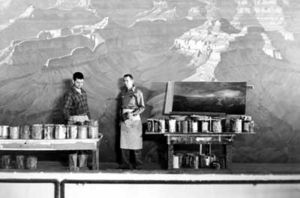
The 1958 addition of the "Grand Canyon" diorama painted by artist Delmer J. Yoakum (added to what was once a long tunnel through a backstage service area) necessitated a change in the rolling stock as well; instead of facing forward, the new flatcars' benches now faced right so that the passengers could better enjoy the scenes. The diorama, which includes the park's only taxidermic animals in lifelike poses, is the longest in the world. Painted on a single piece of seamless canvas and representing the view from the canyon's south rim, the rear of the diorama measures 306 feet (93 m) long, 34 feet (10 m) high and is covered with 300 gallons (1,100 L) of paint.
The cost was US$367,000 and took more than 80,000 labor hours to construct. The main theme of Ferde Grofe's "On The Trail" is piped in through the train's sound system as it enters the diorama. In 1966, the diorama was expanded with a prehistoric theme to become the "Grand Canyon/Primeval World" diorama, with Audio-Animatronic dinosaurs from Walt Disney's Ford Magic Skyway attraction at the 1964 New York World's Fair. A 96-year-old Hopi chief, Chief Nevangnewa, blessed the trains on the diorama's opening day.
Alterations and modernization
The 1969 installation and opening of The Haunted Mansion required minor realignment of the main line since part of the new attraction extended beneath the roadbed. The DLRR was in near-continuous operation since the park's 1955 opening day until December 2004 when the system was shut down for reballasting, regauging and new block signals as part of Disneyland's fiftieth anniversary celebration.
In 1999, Disney purchased the inoperable Maud L locomotive from the Cedar Point Amusement Park in Sandusky, Ohio, and sent it to a Southern California shop in 2004 to restore it and transform it into a Disneyland Railroad locomotive. This 1902 Baldwin loco is now Disneyland Railroad locomotive number 5 and is the first added since 1959. Originally named for Maud Lepine, daughter of one of the original owners and a name kept throughout the locomotive's service life, it is now named after the late Ward Kimball, one of Disney's Nine Old Men and an avid railroad preservationist.
The attraction reopened on March 17, 2005. It was the railroad's longest closure in park history.
Stations
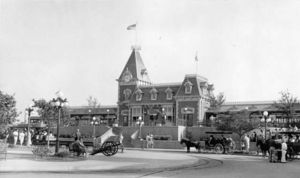
The 1.5-mile (2.4 km) loop originally only stopped at Main Street, USA and Frontierland, but now stops at Mickey's Toontown and Tomorrowland as well. Main Street Station is designed to coordinate architecturally with the rest of Main Street, and is the first Disneyland structure visitors see upon entering the park. A sign on the roof shows an elevation of 138 feet (42 m) above sea level and a population number that roughly corresponds with the number of visitors to the park over the past five decades. As of January 2005 the number stood at 500 million. A handcar is on permanent display on a siding in front of the station that once allowed two trains to run the loop, while passing each other at the two original stations. It was donated to Walt Disney himself around 1964 by its maker, Kalamazoo Manufacturing. A replica of the locomotive Lilly Belle is on display inside the station as are various print articles pertaining to the DLRR.
The onetime Frontierland station stop now serves New Orleans Square. Its station is a platform whose canopy is of similar style to that at Main Street Station. A building on the opposite side of the tracks (inspired by Ward Kimball's Grizzly Flats depot) once served as the station platform; it was removed from service in 1962 and now serves primarily as an ornamental detail and break room for train crews. The telegraph sound effect that can be heard emanating from the building is morse code, which was used by telegraphers on operating railroads, that repeats the first two lines of Walt Disney's 1955 opening day speech.
Fantasyland Station was rethemed to a somewhat "cartoonish" design in 1992 to correspond with the new Mickey's Toontown, which opened in January, 1993. Tomorrowland's station features a Googie-style architectural design and was originally light blue (the exit signs are still white and blue), but was repainted copper, brown, and orange in 1998 to correspond with the new Tomorrowland color scheme. The station has recently undergone renovation with new metal railings and pavement. For unknown reasons, the station was left with its 1998 colors and its new elements were the same color. This section of Tomorrowland was not painted in time for the fiftieth anniversary celebration and will most likely be completed in the off-season.
The voice of the stationmaster who announces the arrival of a train at each stop is that of actor Pierre "Pete" Renoudet, a Disney studio employee.
Locomotives
All the Disneyland locomotives burn diesel fuel, which is less polluting (though more expensive) than the coal, wood, or heavy "Bunker C" oil normally used on steam locomotives.
The Disneyland Railroad currently has five narrow-gauge steam locomotives (the original four are named after former Santa Fe CEOs):
- 1: C.K. Holliday, a 4-4-0 built in the Walt Disney Studio in 1954; went into service at Disneyland on Opening Day, 1955. Named for Cyrus Kurtz Holliday, founder of the Santa Fe Railroad in 1859.
- 2: E.P. Ripley, a 4-4-0 built in the Walt Disney Studio in 1954; went into service at Disneyland on Opening Day, 1955. Named for Edward Payson Ripley, an early president of the ATSF after its 1895 reorganization.
- 3: Fred Gurley, built by Baldwin Locomotive Works in 1894, went into service at Disneyland March 28, 1958. The locomotive, named for the then-current chairman of the ATSF, Fred G. Gurley, is the oldest single piece of railroad equipment in use at any Disney theme park. The 2-4-4T tank locomotive, used in Louisiana to transport sugar cane, was purchased in working condition for US$1300; nevertheless, more than $35,000 was spent on its restoration. A commemorative brass plaque celebrating the Gurley's centennial was mounted in the cab in 1994.
- 4: Ernest S. Marsh, a 2-4-0 built by Baldwin Locomotive Works in 1925; went into service at Disneyland July 25, 1959. Named for the Santa Fe's then-current president, the Marsh originally served the Raritan River Sand Company in New Jersey. During shipment from New Jersey to California, the locomotive was misrouted and ended up in a rail yard outside Pittsburgh. Disney placed a call to personal friend Marsh who personally oversaw the rerouting and rapid shipment of the locomotive to its final destination.
- 5: Ward Kimball, a 0-4-4T Forney, serial number 20925, built by Baldwin Locomotive Works in 1902 for the Laurel Valley Plantation of Louisiana and later received in trade from Cedar Point Amusement Park as the inoperative Maud L in 1999. Cedar Point added a lead truck during its service there, making it a 2-4-4T. Restoration was begun by Boschan Boiler and Restorations of Carson in 2004 and the unit went into permanent service on June 25, 2005, as part of the park's fiftieth anniversary celebration. Named for the famous Disney animator, the Kimball makes a slight break from tradition as well. Since the DLRR's inauguration, no Disney characters have been depicted on the rolling stock or at the stations in order to enforce the image of the railroad as a genuine, working system. The new locomotive's headlight features a gold leaf silhouette of Jiminy Cricket, a Ward Kimball creation. The silhouette is based on a drawing of the character Kimball made shortly before his death.
Attraction facts
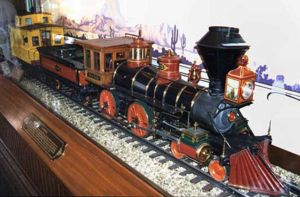
- Grand opening: July 17, 1955 (Opened with Disneyland Park)
- Designer: WED Enterprises
- Original name: Santa Fe & Disneyland Railroad (1955-1976)
- Locomotives: 5
- Track length: 1.2 miles
- Show length: 18:00
- Required ticket: "D"
- Ride system: Narrow-gauge steam train
Trivia
- To offset construction costs, the Walt Disney Company solicited a number of major railroads for corporate sponsorship of the attraction in 1953; the Santa Fe was the only company to respond.
- From 1955 until 1974 (when the railroad's sponsorship ended), the Santa Fe "rail pass" was honored in lieu of the required "D" coupon.
- The narration provided inside the cars at various points throughout the trip around the park once featured the late voice actor Vic Perrin, and later, Thurl Ravenscroft.
- By Disneyland's own estimates, the trains make more than 13,000 trips around the park annually.
- There are also Disneyland Railroads at Disneyland Paris and Hong Kong Disneyland.
- Ever since the trains first started operating in 1955, they have covered enough track to circle the globe more than 150 times.
- May 6-7, 2006 the E.P. Ripley was displayed at the annual Fullerton Railroad Days in Fullerton, California. This was the first time any of the locomotives has been displayed at a public event off-site.
Footnotes
References
- Duke, Donald (1997). Santa Fe: The Railroad Gateway to the American West, Volume One. Golden West Books, San Marino, California. ISBN 0-87095-110-6.
- (1979). Disneyland: The First Quarter Century. Walt Disney Productions, Burbank, California.
- (2000). Guide to Tourist Railroad and Museums. Kalmbach Publishing Co., Waukesha, Wisconsin. ISBN 0-89024-424-3
- Trahan, Kendra D. (2004). Disneyland Detective: An INDEPENDENT Guide to Discovering Disney's Legend, Lore, and Magic! PermaGrin Publishing, Inc., Mission Viejo, California. ISBN 0-9717464-0-0
- DeGaetano, Steve M. (2004). Welcome Aboard the Disneyland Railroad! The Complete Disneyland Railroad Reference Guide Steam Passages Publications, Winnetka, California. ISBN 0-9758584-0-8
See also
- Delmer J. Yoakum
- Disneyland Viewliner
- List of current Disneyland attractions
- List of heritage railways
- Walt Disney World Railroad
External links
- The Carolwood Pacific Historical Society (CPHS) rededication of Engine #3, the Roger E. Broggie
- "Hidden Mickey's Secrets of the Magic Kingdom Railroad" webpage
- "History of: the Disneyland Railroad" webpage
- The "Magic Behind the Steam Trains Tour" webpage
- "The Santa Fe and Disneyland Railroad" website
- DRR 5 is alive - The story behind locomotive number 5.
